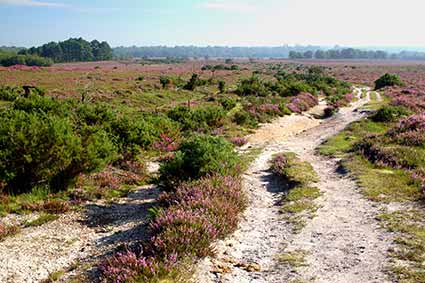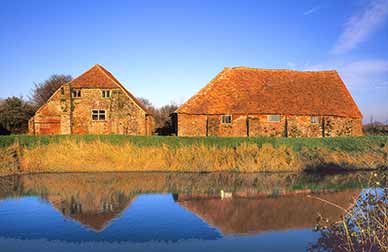The Salt Way

Old trackways have a fascination all their own, recalling travellers from far-off days winding their way on foot or horseback at speeds many today would consider slower than snail’s pace.
The New Forest Salt Way is one such route, shown close to Lyndhurst on the late-18th century Richardson, King and Driver map of the area - the New Forest Salt Way runs diagonally from left to right across the map page.
But first, a bit of background.
For many years, salt has been an important commodity, and not just for culinary purposes - it was also used as part of the tanning process, and before the invention of fridges and freezers, as a preservative, the only means by which meat and other foodstuffs could effectively be stored for any length of time.
Since at least the Iron Age, salt was extracted from sea-water by evaporation at places along the coast, including, in Hampshire, the stretch between Lymington and Hurst. It was carried inland using donkeys or packhorses along routes such as the Salt Way, which therefore may have been used for over 2,000 years!
But 19th century taxation, competition from Cheshire salt mines, and greatly improved transport using the newly introduced railways, made the coastal salt trade uneconomic, and so the old salterns fell into disuse. Locally, little evidence remains of this once prosperous trade, save for two 18th century buildings at Woodside, near Pennington, reached from the Solent by a man-made channel used to bring in coal and take out salt.
Family operated working examples can, however, still be seen across the Channel on the French coast, where the kinder climate allows a longer working season.
The New Forest Salt Way, part of a route to Southampton, and probably Winchester and beyond, left what is now the A337 Lyndhurst to Brockenhurst road close to Hollands Wood camp site, near Brockenhurst’s Balmer Lawn. Marked on the old map as the Cock Road, this is probably a reference to the woodcock, a relatively common New Forest woodland bird.

Woodside, near Lymington
Much of the early route passed through unenclosed woodlands and over open heaths, but these were largely subsumed by 19th century woodland inclosure. The Salt Way can, however, still be walked in the drift-way between Pondhead Inclosure and Park Hill; across Parkhill Lawn; and along a track leading from Pondhead Farm (A). It passes what Richardson, King and Driver show as a Bridle way from Beaulieu to Minstead, before crossing White Moor and reaching Longwater Lawn.
From here, the Salt Way continued north-east across what was Old Ralph Heath, to emerge onto the current A35 Lyndhurst-Ashurst road, close to the camp site, and not far from the remains of an Elizabethan saltpetre factory, which shows on the old map, close to a turnpike milestone, as a rectangular enclosure marked Salt petre bank.
It seems purely coincidence that the Elizabethans set up their saltpetre factory so close to the Salt Way, unless, of course, they were attracted by the transport potential of the site. Saltpetre was a component of gunpowder that also had uses as a food preservative, but coastal salt was not used in its manufacture.
References:
Lyndhurst Historical Society publications: Roy Jackman
Lyndhurst – A Brief History and Guide: Georgina Babey and Peter Roberts
The Salterns of the Lymington Area: Arthur T Lloyd, BA
More links
Other related links
Search this site

Sadly, 58 animals were killed - 35 ponies, 13 cows, 8 donkeys and 2 sheep, whilst a further 32 were injured - 3 pigs, 9 donkeys, 11 cows and 9 ponies.
(Forty-three accidents occurred in daylight, 15 at twilight and 101 in the dark. Twenty-seven accidents were not reported by the driver involved).
Here's just one horrific example - Three donkeys killed in collision with van at notorious New Forest blackspot (Advertiser and Times)

